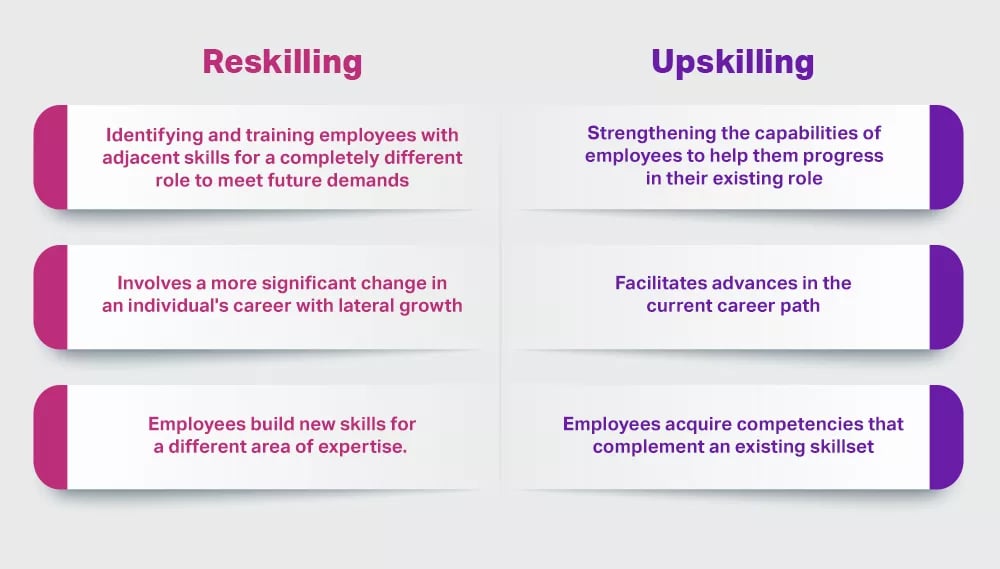
6 min read
• 18 Oct 2023
The Power of Employee Reskilling: Future-Proof Your Workforce
Employee reskilling is necessary to future-proof your workforce. Discover the meaning of reskilling and the importance of reskilling your employees.
-
eBookEmployee Upskilling - A Detailed Blueprint For Building A Skills-Driven Learning Culture
The Global Skill Report by Cousera stated by the middle of this decade, an estimated 85 million jobs may disappear, while another 97 million new ones will take their place.
Employee reskilling is of paramount importance for building a thriving ecosystem in an era of exponential change. The drive towards a digital future, employee demands for career advancement and the evolving nature of work are pushing companies to prioritize reskilling to ensure their success. A future-ready and agile workforce is a must to straddle these changing industry dynamics.
What is reskilling?
Employee reskilling is the process of training current employees to acquire new skills for handling a different role in the company. For instance, an in-store sales rep is reskilled to work as a customer service executive to drive e-commerce sales. Reskilling creates a win-win for both businesses and employees. Businesses can address their staffing needs, and employees get career mobility along with flexibility to grow within the company. Hence companies are becoming more growth-oriented and equipping their employees with the skill sets necessary for the changing job market.
Reskilling is crucial for businesses to stay competitive in rapidly evolving industries. The auto industry’s transition to EVs is one of the best examples highlighting the need for employee reskilling in electric mobility. This shift created new job opportunities in areas such as EV design and manufacturing. Industries everywhere are embracing reskilling to keep up with technological advancements and changing customer needs.
A study by Josh Bersin Company found that “ Companies that focus on growth are 29 times more likely to let employees “unleash their potential,” 4 times more likely to be innovation leaders, and 7.2 times more likely to be best places to work.
Reskilling vs Upskilling – What is the difference?
Most companies often get confused between reskilling and upskilling. They tend to use it interchangeably. Though they sound similar, they are two entirely different concepts.

Why is reskilling important?
The U.S. Chamber of Commerce’s study on labor shortage showed that in 2022, a historic 4.5 million jobs were created by employers. Additionally, Forbes conducted a survey among HR professionals and found that 83% reported difficulty in locating suitable candidates for critical job positions, with 75% stating that the majority of job applicants were lacking necessary job skills.
There is a talent shortage, with new roles reshaping the workplace due to digital transformation. Additionally, employees are considering career cushioning and looking for new opportunities due to fear of recession. In this light, it is critical for companies to win the trust and retain the best in-house talent by offering internal mobility through reskilling. This not only benefits the employees by enabling them to learn new skills for different job paths, but it also fosters a positive and productive work environment and reduces employee turnover.

6 Benefits of Reskilling
Reskilling is a mutually beneficial endeavor that helps companies retain their best talents and enables employees to expand their expertise in a different area. Below are the benefits the companies and employees receive by putting in time and effort in reskilling.
Benefits of employee reskilling for Companies
1. Attract and retain top talent
Garner the attention of the millennial and Gen Z labor market who prefer to join and remain with companies that give them the flexibility to evolve and pursue their career aspirations.
2. Drive employee engagement and reduce hiring costs through training
Training existing employees to take up new challenges helps in gaining their loyalty. Moreover, their knowledge about the company and product makes it easier for them to assume new responsibility and helps you save costs on hiring, onboarding and training new employees.
Companies with highly engaged workforces are 21% more profitable.
3. Meet Future Demands
Reskilling empowers employees to seamlessly move between roles to help the company innovate and gain a competitive edge for capitalizing on any opportunity that comes their way.
Companies have zero time to lose. In an increasingly winner-takes-all business environment, 95% of economic profit is earned by the top 20% of companies.
Benefits of reskilling for Employees
4. Ensure stability amidst disruption
With the likelihood of parts of the world heading into recession and the anxiety of unemployment, it is crucial to have a secured and quality job that facilitates continuous growth within the company.
25% of workers said it was “very” or “fairly likely” that they would become unemployed this year.
5. Career advancement opportunities
Becoming eligible for new positions will allow; employees to climb the career ladder and become more valuable to the company. The reskilling effort will reduce employee turnover and bridge talent gaps needed for new positions.
30% of employees considered career development opportunities for learning and personal growth very important.
6. Develop a continuously learning culture
Employees can hone new skills constantly in a company that facilitates continuous learning. It helps them become more agile to adopt and pivot seamlessly as the business evolves
74% of employees are ready to learn new skills in order to remain employable in the future.
How to build an employee reskilling program for your organization – 6 Best Practices
Unlocking the potential within the organization is the key to sustainability in the future of work. Let’s dive into the steps to build an employee reskilling program that helps leverage the current employees and resources to the fullest before having to recruit to access talent from the labor market.
1. Identify new roles based on the defined business goals
- Commence by tracking the technological advances in your market and anticipate the skills evolving in your industry.
- Ponder over the business requirements.
- Assess the skills gap between the current role and the requirements.
- Based on the assessment, identify the new roles required within your organization.
2. Map skills needed for each role
- Once you identify the new roles, create a skill repository for each.
- Conduct research and determine the skill sets needed for each role.
- Divide the skill repository into functional, leadership and digital skills.
- Define proficiency level for each position. For instance, if we take the above EV example, for the Printed Circuit Board (PCB) layer stack-up skill, a PCB Designer executive should be at level 2 while a manager should be a level 4.
3. Determine which employees to reskill and when
- Start by seeking adjacent existing skill sets in a role that requires skills that are close to the ‘new’ skills required. For instance, sales reps are good at customer-facing type skills, so they can easily transition into a customer support role for an e-commerce site.
- Once you find the right fit for the new role, gauge the interest level of the individual.
- Have a discussion with the employee to ensure they are willing to assume the new responsibilities.
- Evaluate the interested candidate’s knowledge in the new skill to find the skills gap and accordingly build the reskilling program.
4. Identify the right reskilling platform
- Use the power of a learning platform to personalize and deliver the reskilling program.
- Conduct a skilling needs analysis.
- Research the market for a reskilling platform for employee training.
- A skills-driven system like an LXP platform can help you manage your entire reskilling effort efficiently and effectively.
- Opt for an LXP that enables you to:
- Identify and map the skills already defined and provided by the system.
- Utilize the platform to create a skilling journey and assign it to the right learners.
- Find a platform that will conduct assessments to evaluate current skill scores.
- Create a learning journey with various modules like blogs, videos, etc.
- Make learning personalized with An AI-powered tool like Disprz LXP that automatically recommends modules based on the skills mapped.
- Define a career path to give employees visibility into how they can evolve in a potential new role.
- Access skilling analytics to track the learning process and measure the impact on performance.
Step 5. Choose the best reskilling method
- You can reskill the employee through synchronous learning with instructor led classroom sessions or role-playing.
- You can even conduct asynchronous learning through on-the-job training with an LXP platform.
- One of the best ways to reskill employees is through blended learning where you merge both asynchronous and synchronous learning to drive better results. For instance, during a live session, an L&D professional can share techniques to send prospecting emails and later assign courses to the employee with detailed resources as well as email templates for creating prospecting emails.
Step 6. Track and analyze reskilling analytics
- Measure the effectiveness of your learning programs by digging into learning insights.
- Evaluate key metrics like completion rate, total learning hours, and the overall percentage of completed assessments.
- Use an LXP with advanced skill analytics capabilities, so you can monitor employee’s enhancement of knowledge in their assigned skills for the new role.
- Analyze the learning journey and the assessments corresponding to the skills associated with each journey.
- Use learning insights to display how your reskilling initiatives have contributed to the business goals.
Conclusion
Employee reskilling can help you future-proof your business by having a highly skilled workforce to meet current and future needs. All you need to do is take the right steps to reskill your employees. Below we’ve summarized the steps to help you reskill your employees:
- Assess your business needs.
- Identify the roles to achieve those business needs.
- Determine and benchmark skills for the new roles.
- Look for adjacent skills to identify the right talent for the roles.
- Use advanced technology like an LXP platform to reskill your employees.
- Choose the best reskilling method.
- Analyze and refine your reskilling process.
It all boils down to the technology you use and the practices you follow for designing and implementing reskilling programs. Therefore, make sure you implement an AI-based, mobile LXP platform that’s powered with rich features to help manage all the steps above for reskilling employees. Check out cutting-edge LXP that is richly designed to address your needs.
About the author

Debashree Patnaik
Debashree is a seasoned content strategist at Disprz.ai, specializing in enterprise learning and skilling. With diverse experience in B2B and B2C sectors, including ed tech, she leads the creation of our Purple papers, driving thought leadership. Her focus on generative AI, skilling, and learning reflects her commitment to innovation. With over 6 years of content management expertise, Debashree holds a degree in Aeronautical Engineering and seamlessly combines technical knowledge with compelling storytelling to inspire change and drive engagement.
More Resources
4 min read
• 15 Apr 2024
Unlocking the Power of Managerial Engagement in Talent Development
4 min read
• 09 Apr 2024
Nurturing Excellence in Building Leadership Pipelines
Sign up to get free resources and stay up to date with Disprz!
Discover how Disprz can align learning and upskilling with your desired business outcomes.





